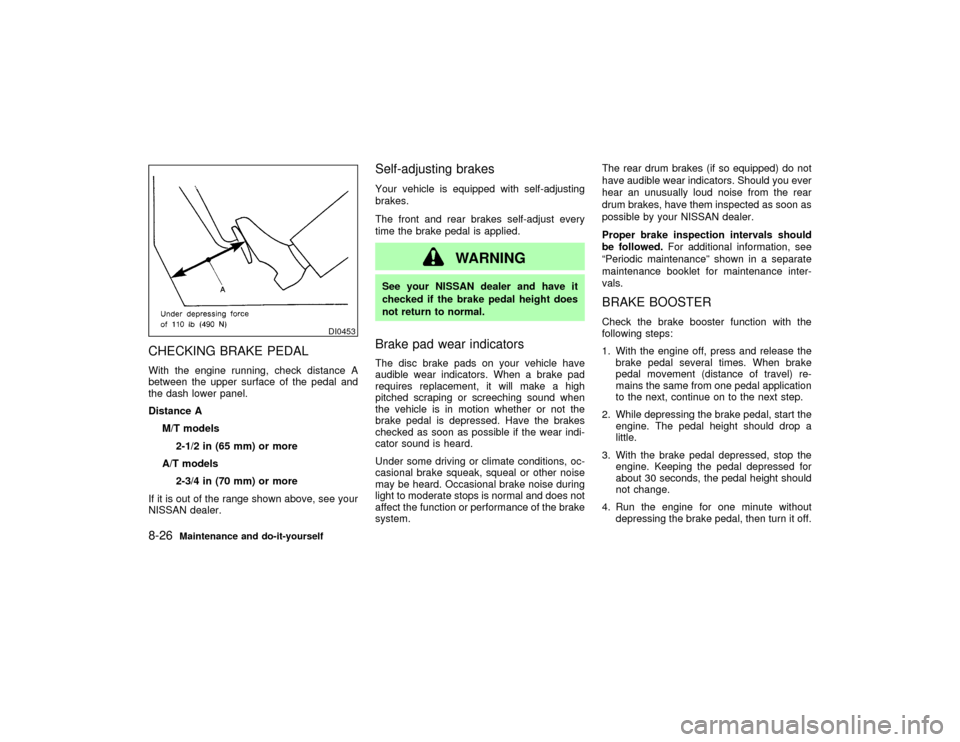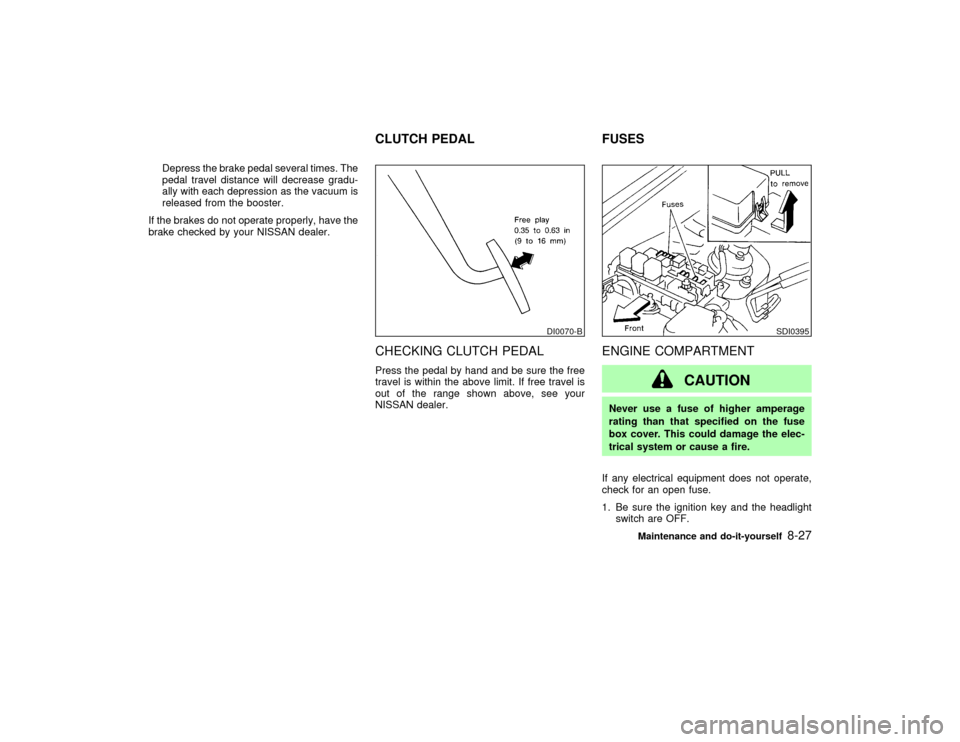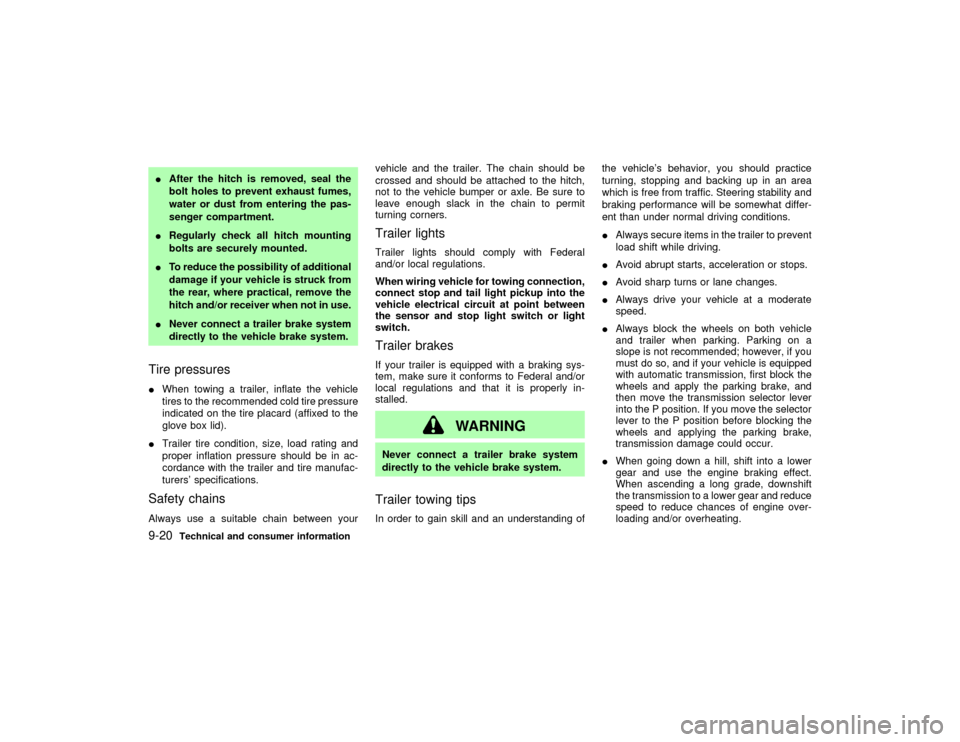check engine light NISSAN PATHFINDER 2002 R50 / 2.G Owner's Manual
[x] Cancel search | Manufacturer: NISSAN, Model Year: 2002, Model line: PATHFINDER, Model: NISSAN PATHFINDER 2002 R50 / 2.GPages: 288, PDF Size: 2.49 MB
Page 235 of 288

CHECKING BRAKE PEDALWith the engine running, check distance A
between the upper surface of the pedal and
the dash lower panel.
Distance A
M/T models
2-1/2 in (65 mm) or more
A/T models
2-3/4 in (70 mm) or more
If it is out of the range shown above, see your
NISSAN dealer.
Self-adjusting brakesYour vehicle is equipped with self-adjusting
brakes.
The front and rear brakes self-adjust every
time the brake pedal is applied.
WARNING
See your NISSAN dealer and have it
checked if the brake pedal height does
not return to normal.Brake pad wear indicatorsThe disc brake pads on your vehicle have
audible wear indicators. When a brake pad
requires replacement, it will make a high
pitched scraping or screeching sound when
the vehicle is in motion whether or not the
brake pedal is depressed. Have the brakes
checked as soon as possible if the wear indi-
cator sound is heard.
Under some driving or climate conditions, oc-
casional brake squeak, squeal or other noise
may be heard. Occasional brake noise during
light to moderate stops is normal and does not
affect the function or performance of the brake
system.The rear drum brakes (if so equipped) do not
have audible wear indicators. Should you ever
hear an unusually loud noise from the rear
drum brakes, have them inspected as soon as
possible by your NISSAN dealer.
Proper brake inspection intervals should
be followed.For additional information, see
ªPeriodic maintenanceº shown in a separate
maintenance booklet for maintenance inter-
vals.
BRAKE BOOSTERCheck the brake booster function with the
following steps:
1. With the engine off, press and release the
brake pedal several times. When brake
pedal movement (distance of travel) re-
mains the same from one pedal application
to the next, continue on to the next step.
2. While depressing the brake pedal, start the
engine. The pedal height should drop a
little.
3. With the brake pedal depressed, stop the
engine. Keeping the pedal depressed for
about 30 seconds, the pedal height should
not change.
4. Run the engine for one minute without
depressing the brake pedal, then turn it off.
DI0453
8-26
Maintenance and do-it-yourself
Z
01.9.21/R50-D/V5
X
Page 236 of 288

Depress the brake pedal several times. The
pedal travel distance will decrease gradu-
ally with each depression as the vacuum is
released from the booster.
If the brakes do not operate properly, have the
brake checked by your NISSAN dealer.
CHECKING CLUTCH PEDALPress the pedal by hand and be sure the free
travel is within the above limit. If free travel is
out of the range shown above, see your
NISSAN dealer.
ENGINE COMPARTMENT
CAUTION
Never use a fuse of higher amperage
rating than that specified on the fuse
box cover. This could damage the elec-
trical system or cause a fire.
If any electrical equipment does not operate,
check for an open fuse.
1. Be sure the ignition key and the headlight
switch are OFF.
DI0070-B
SDI0395
CLUTCH PEDAL FUSES
Maintenance and do-it-yourself
8-27
Z
01.9.21/R50-D/V5
X
Page 237 of 288

2. Open the engine hood.
3. Remove the fuse box cover.
4. Remove the fuse with the fuse puller.
5. If the fuse is open, replace it with a new
fuse.
6. If a new fuse opens again, have the elec-
trical system checked and repaired by your
NISSAN dealer.Fusible linksIf any electrical equipment does not operate
and fuses are in good condition, check the
fusible links. If any of these fusible links are
melted, replace only with genuine NISSAN
parts.
PASSENGER COMPARTMENTIf any electrical equipment does not operate,
check for an open fuse.
1. Be sure the ignition key and the headlight
switch are OFF.
2. Pull to open the fuse box cover/coin tray.
3. Pull down the fuse box cover/coin tray to
remove it.
4. Remove the fuse with the fuse puller.
5. If the fuse is open, replace it with a new
fuse.6. If a new fuse opens again, have the elec-
trical system checked and repaired by your
NISSAN dealer.
SDI1169
8-28
Maintenance and do-it-yourself
Z
01.9.21/R50-D/V5
X
Page 256 of 288

fuel additives (i.e.: fuel injector cleaner, octane
booster, intake valve deposit removers, etc.)
which are sold commercially. Many of these
additives intended for gum, varnish or deposit
removal may contain active solvents or similar
ingredients that can be harmful to the fuel
system and engine.Octane rating tipsIn most parts of North America, you should use
unleaded gasoline with an octane rating of at
least 91 AKI (Anti-Knock Index) number
(VQ35DE engine) or 87 AKI (Anti-knock Index)
number (VG33E engine). However, you may
use unleaded gasoline with an octane rating
as low as 85 AKI (Anti-Knock Index) number in
these high altitude areas [over 4,000 ft (1,219
m)] such as: Colorado, Montana, New Mexico,
Utah, Wyoming, northeastern Nevada, south-
ern Idaho, western South Dakota, western
Nebraska, and that part of Texas which is
directly south of New Mexico.
Using unleaded gasoline with an octane
rating lower than stated above can cause
persistent, heavy spark knock. (Spark
knock is a metallic rapping noise.) If se-
vere, this can lead to engine damage. If you
detect a persistent heavy spark knock even
when using gasoline of the stated octane
rating, or if you hear steady spark knockwhile holding a steady speed on level
roads, have your dealer correct the condi-
tion. Failure to correct the condition is
misuse of the vehicle, for which NISSAN is
not responsible.
Incorrect ignition timing will result in knocking,
after-run or overheating. This in turn may
cause excessive fuel consumption or damage
to the engine. If any of the above symptoms
are encountered, have your vehicle checked at
a NISSAN dealer or other competent service
facility.
However, now and then you may notice
light spark knock for a short time while
accelerating or driving up hills. This is no
cause for concern, because you get the
greatest fuel benefit when there is light
spark knock for a short time.
Technical and consumer information
9-5
Z
01.9.21/R50-D/V5
X
Page 271 of 288

IAfter the hitch is removed, seal the
bolt holes to prevent exhaust fumes,
water or dust from entering the pas-
senger compartment.
IRegularly check all hitch mounting
bolts are securely mounted.
ITo reduce the possibility of additional
damage if your vehicle is struck from
the rear, where practical, remove the
hitch and/or receiver when not in use.
INever connect a trailer brake system
directly to the vehicle brake system.Tire pressuresIWhen towing a trailer, inflate the vehicle
tires to the recommended cold tire pressure
indicated on the tire placard (affixed to the
glove box lid).
ITrailer tire condition, size, load rating and
proper inflation pressure should be in ac-
cordance with the trailer and tire manufac-
turers' specifications.Safety chainsAlways use a suitable chain between yourvehicle and the trailer. The chain should be
crossed and should be attached to the hitch,
not to the vehicle bumper or axle. Be sure to
leave enough slack in the chain to permit
turning corners.
Trailer lightsTrailer lights should comply with Federal
and/or local regulations.
When wiring vehicle for towing connection,
connect stop and tail light pickup into the
vehicle electrical circuit at point between
the sensor and stop light switch or light
switch.Trailer brakesIf your trailer is equipped with a braking sys-
tem, make sure it conforms to Federal and/or
local regulations and that it is properly in-
stalled.
WARNING
Never connect a trailer brake system
directly to the vehicle brake system.Trailer towing tipsIn order to gain skill and an understanding ofthe vehicle's behavior, you should practice
turning, stopping and backing up in an area
which is free from traffic. Steering stability and
braking performance will be somewhat differ-
ent than under normal driving conditions.
IAlways secure items in the trailer to prevent
load shift while driving.
IAvoid abrupt starts, acceleration or stops.
IAvoid sharp turns or lane changes.
IAlways drive your vehicle at a moderate
speed.
IAlways block the wheels on both vehicle
and trailer when parking. Parking on a
slope is not recommended; however, if you
must do so, and if your vehicle is equipped
with automatic transmission, first block the
wheels and apply the parking brake, and
then move the transmission selector lever
into the P position. If you move the selector
lever to the P position before blocking the
wheels and applying the parking brake,
transmission damage could occur.
IWhen going down a hill, shift into a lower
gear and use the engine braking effect.
When ascending a long grade, downshift
the transmission to a lower gear and reduce
speed to reduce chances of engine over-
loading and/or overheating.
9-20
Technical and consumer information
Z
01.9.21/R50-D/V5
X
Page 280 of 288

10 Index
A
ABS (Anti-lock brake system) ......................... 5-32
Air bag system
Front (See supplemental front airbag
system) ...................................................... 1-16
Side (See supplemental side air bag
system) ...................................................... 1-18
Air bag warning labels .................................... 1-20
Air bag warning light.............................. 1-21, 2-12
Air cleaner housing filter ................................. 8-23
Air conditioner
Air conditioner operation ...................... 4-2, 4-8
Air conditioner service ................ 4-2, 4-8, 4-10
Air conditioner specification label.............. 9-14
Air conditioning system refrigerant and
lubricant recommendations ................ 4-10, 9-8
Heater and air conditioner (automatic) ....... 4-8
Heater and air conditioner controls ............. 4-2
Servicing air conditioner .............................. 4-2
Air conditioner operation, Semiautomatic ......... 4-5
Air flow charts ................................................... 4-5
Alcohol, drugs and driving ................................ 5-4
Anchor point locations
Top tether strap ......................................... 1-41
Antenna........................................................... 4-31
Anti-lock Brake System (ABS) ........................ 5-32
Anti-lock brake warning light............................. 2-9Appearance care
Exterior appearance care ............................ 7-2
Interior appearance care ............................. 7-3
Armrest ............................................................. 1-9
Ashtray (See cigarette lighter and ashtray) .... 2-26
ATP warning light ........................................... 2-10
Audible reminders ........................................... 2-15
Audio operation precautions ........................... 4-12
Audio system .................................................. 4-11
Steering wheel audio controls ................... 4-30
Automatic
Automatic transmission fluid (ATF) ........... 8-16
Drive positioner ......................................... 3-16
Driving with automatic
transmission ....................................... 5-6, 5-10
Seat positioner, seat ................................. 3-16
Transmission park warning light ............... 2-10
Transmission selector lever lock release .. 5-13
Avoiding collision and rollover .......................... 5-4
B
Battery............................................................. 8-21
Battery saver system................................. 2-20
Battery replacement, (See remote keyless entry
system) ............................................................. 3-8
Before starting the engine ................................ 5-9
Belts (See drive belts) .................................... 8-22Brake
Anti-lock brake system (ABS) ................... 5-32
Brake and clutch fluid................................ 8-18
Brake booster ............................................ 8-26
Brake fluid ................................................. 8-18
Brake pedal ............................................... 8-25
Brake pedal check..................................... 8-26
Brake system............................................. 5-32
Parking brake check ........................ 5-16, 8-25
Parking brake operation ............................ 5-16
Warning light ............................................. 2-10
Break-in schedule ........................................... 5-19
Bulb check/instrument panel ............................ 2-9
Bulb replacement ............................................ 8-30
C
Capacities and recommended fuel/lubricants... 9-2
Car phone or CB radio ................................... 4-32
Cargo (See vehicle loading information) ........ 2-33
Cargo net ........................................................ 2-33
Cassette player (See audio system) .... 4-16, 4-23,
4-28
Catalytic converter, Three way catalyst............ 5-3
CD care and cleaning ..................................... 4-26
Child restraints ................................................ 1-31
Installation on front passenger seat .......... 1-42
Installation on rear seat outboard
positions .................................................... 1-35
Z
01.9.21/R50-D/V5
X
Page 281 of 288

Installation on rear seat center position .... 1-33
Precautions on child restraints .................. 1-31
Top tether strap anchor point locations .... 1-41
With top tether strap.................................. 1-40
Child safety ..................................................... 1-24
Child safety rear door lock................................ 3-4
Chimes, Audible reminders............................. 2-15
Cigarette lighter and ashtray .......................... 2-26
Circuit breaker, Fusible link ............................ 8-28
Cleaning exterior and interior .................... 7-2, 7-3
Clock ............................................................... 2-25
Clutch
Clutch pedal .............................................. 8-27
Fluid ........................................................... 8-18
Clutch housing drain (4x4 only) ...................... 8-40
Cold weather driving ....................................... 5-34
Compact Disc (CD) player (See audio
system) ........................................................... 4-17
Compact spare tire ......................................... 8-39
Compass display .............................................. 2-7
Console box .................................................... 2-30
Controls
Heater and air conditioner controls ............. 4-2
Heater and air conditioner controls
(automatic)................................................... 4-8
Heater and semiautomatic air conditioner .. 4-3
Steering wheel audio controls ................... 4-30
Coolant
Capacities and recommended fuel/
lubricants ..................................................... 9-2
Changing engine coolant .......................... 8-10
Checking engine coolant level .................... 8-9
Corrosion protection ......................................... 7-4
Cover, Tonneau cover .................................... 2-33Cruise control.................................................. 5-17
Cup holders .................................................... 2-28
D
Daytime running light system ......................... 2-21
Defogger switch, Glass hatch and outside mirror
defogger switch............................................... 2-19
Dimensions and weights ................................. 9-11
Door open warning light ................................. 2-11
Drive belts ....................................................... 8-22
Drive positioner, Automatic ............................. 3-16
Driving
Cold weather driving ................................. 5-34
Driving with automatic transmission .. 5-6, 5-10
Driving with manual transmission ...... 5-7, 5-14
On-pavement and offroad driving ............... 5-3
Precautions when starting and driving ........ 5-2
Safety precautions....................................... 5-4
E
Economy, Fuel ................................................ 5-19
Electric sunroof ............................................... 2-36
Emission control information label .................. 9-14
Emission control system warranty .................. 9-22
Engine
Before starting the engine ........................... 5-9
Block heater .............................................. 5-35
Capacities and recommended fuel/
lubricants ..................................................... 9-2
Changing engine coolant .......................... 8-10
Changing engine oil .................................. 8-14Changing engine oil filter .......................... 8-15
Checking engine coolant level .................... 8-9
Checking engine oil level .......................... 8-13
Coolant temperature gauge ........................ 2-4
Engine compartment check locations ......... 8-7
Engine cooling system ................................ 8-9
Engine oil................................................... 8-13
Engine oil and oil filter recommendation..... 9-6
Engine oil viscosity ...................................... 9-6
Engine serial number ................................ 9-13
Engine specifications................................... 9-9
If your vehicle overheats ........................... 6-11
Starting the engine ...................................... 5-9
Exhaust gas (Carbon monoxide) ...................... 5-2
F
F.M.V.S.S. certification label........................... 9-13
Filter, Air cleaner housing filter ....................... 8-23
Flashers (See hazard warning flasher
switch) ............................................................. 2-23
Flat tire .............................................................. 6-2
Floor mat cleaning ............................................ 7-4
Fluid
Automatic transmission fluid (ATF) ........... 8-16
Brake and clutch fluid................................ 8-18
Brake fluid ................................................. 8-18
Capacities and recommended fuel/
lubricants ..................................................... 9-2
Engine coolant............................................. 8-9
Engine oil................................................... 8-13
Power steering fluid................................... 8-18
Window washer fluid ................................. 8-20
Z
01.9.21/R50-D/V5
X
10-2
Page 283 of 288

Vanity mirror light ...................................... 2-40
Warning/indicator lights and audible
reminders ........................................... 2-9, 2-13
Loading information (See vehicle loading
information) ..................................................... 9-15
Lock
Door locks ................................................... 3-2
Glass hatch lock ........................................ 3-11
Glove box lock........................................... 2-29
Power door lock .......................................... 3-2
Rear door lock ........................................... 3-10
Rear door opener ...................................... 3-10
Low fuel warning light ..................................... 2-12
Luggage hooks ............................................... 2-32
Luggage rack .................................................. 2-34
M
Maintenance
Battery ....................................................... 8-21
General maintenance .................................. 8-2
Inside the vehicle ........................................ 8-3
Maintenance precautions ............................ 8-5
Outside the vehicle...................................... 8-2
Seat belt maintenance .............................. 1-31
Under the hood and vehicle ........................ 8-4
Manual front seat adjustment ........................... 1-2
Meters and gauges ........................................... 2-3
Mirror
Inside mirror .............................................. 3-15
Outside mirror control................................ 3-15
Outside mirrors .......................................... 3-15N
Net, Cargo net ................................................ 2-33
New vehicle break-in ...................................... 5-19
Nissan vehicle Immobilizer System ................ 2-15
Nissan Vehicle Immobilizer System, Engine
start ................................................................... 5-8
O
Odometer .......................................................... 2-3
Oil
Capacities and recommended fuel/
lubricants ..................................................... 9-2
Changing engine oil .................................. 8-14
Changing engine oil filter .......................... 8-15
Checking engine oil level .......................... 8-13
Engine oil................................................... 8-13
Engine oil viscosity ...................................... 9-6
Outside mirror control ..................................... 3-15
Outside mirrors ............................................... 3-15
Outside temperature display ............................. 2-6
Overdrive switch ............................................. 5-13
Overheat, If your vehicle overheats................ 6-11
P
Parking
Brake check............................................... 8-25
Parking brake check.................................. 5-16
Parking brake operation ............................ 5-16
Parking on hills .......................................... 5-16
Parking/parking on hills .................................. 5-30Personal lights ................................................ 2-39
Phone, Car phone or CB radio ....................... 4-32
Power
Front seat adjustment ................................. 1-4
Power door lock .......................................... 3-2
Power outlet .............................................. 2-25
Power steering fluid................................... 8-18
Power steering system .............................. 5-31
Power windows ......................................... 2-35
Pre-tensioner seat belt system ....................... 1-19
Precautions
Audio operation precautions ..................... 4-12
Braking precautions................................... 5-32
Cruise control operations .......................... 5-18
Cruise control precautions ........................ 5-17
Driving safety............................................... 5-4
Maintenance precautions ............................ 8-5
On child restraints ..................................... 1-31
On seat belt usage .................................... 1-23
On-pavement and offroad driving
precautions .................................................. 5-3
Precautions on supplemental restraint
system ....................................................... 1-10
Precautions when starting and driving ........ 5-2
Push starting ................................................... 6-10
R
Rack, Luggage rack ........................................ 2-34
Radio
Car phone or CB radio .............................. 4-32
Steering wheel audio controls ................... 4-30
Readiness for inspection/maintenance (I/M) test
(US only) ......................................................... 9-23
Z
01.9.21/R50-D/V5
X
10-4